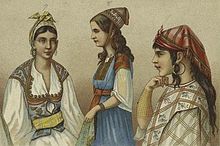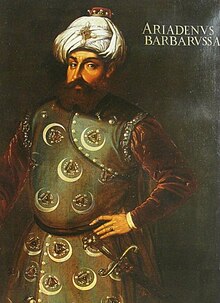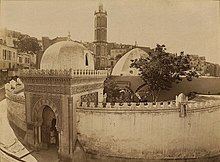
Algeria, officially the People's Democratic Republic of Algeria, is a country in North Africa. Algeria is bordered to the northeast by Tunisia; to the east by Libya; to the southeast by Niger; to the southwest by Mali, Mauritania, and Western Sahara; to the west by Morocco; and to the north by the Mediterranean Sea. It is considered part of the Maghreb region of North Africa. It has a semi-arid climate, with most of the population living in the fertile north and the Sahara dominating the geography of the south. Algeria covers an area of 2,381,741 square kilometres (919,595 sq mi), making it the world's tenth largest nation by area, and the largest nation in Africa, more than 200 times as large as the continent's smallest country, The Gambia. With a population of 44 million, Algeria is the tenth-most populous country in Africa, and the 32nd-most populous country in the world. The capital and largest city is Algiers, located in the far north on the Mediterranean coast.

Turkish people or Turks are the largest Turkic people who speak various dialects of the Turkish language and form a majority in Turkey and Northern Cyprus. In addition, centuries-old ethnic Turkish communities still live across other former territories of the Ottoman Empire. Article 66 of the Turkish Constitution defines a Turk as anyone who is a citizen of Turkey. While the legal use of the term Turkish as it pertains to a citizen of Turkey is different from the term's ethnic definition, the majority of the Turkish population are of Turkish ethnicity. The vast majority of Turks are Muslims and follow the Sunni and Alevi faith.

The Regency of Algiers was a largely independent tributary state of the Ottoman Empire during the early modern period, located on the Barbary Coast of North Africa from 1516 to 1830. Founded by the corsair brothers Aruj and Hayreddin Barbarossa, the Regency was a formidable pirate base infamous for its corsairs. First ruled by Ottoman viceroys, it later became a sovereign military republic that plundered and waged maritime holy war against European Christian powers.
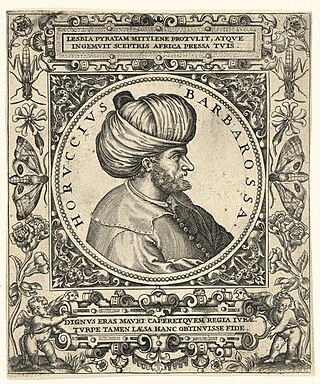
Aruj Barbarossa, known as Oruç Reis to the Turks, was an Ottoman corsair who became Sultan of Algiers. The elder brother of the famous Ottoman admiral Hayreddin Barbarossa, he was born on the Ottoman island of Midilli and died in battle against the Spanish at Tlemcen.

Ottoman Tripolitania, also known as the Regency of Tripoli, was officially ruled by the Ottoman Empire from 1551 to 1912. It corresponded roughly to the northern parts of modern-day Libya in historic Tripolitania and Cyrenaica. It was initially established as an Ottoman province ruled by a pasha (governor) in Tripoli who was appointed from Constantinople, though in practice it was semi-autonomous due to the power of the local Janissaries. From 1711 to 1835, the Karamanli dynasty ruled the province as a de facto hereditary monarchy while remaining under nominal Ottoman suzerainty. In 1835, the Ottomans reestablished direct control over the region until its annexation by Italy in 1912.
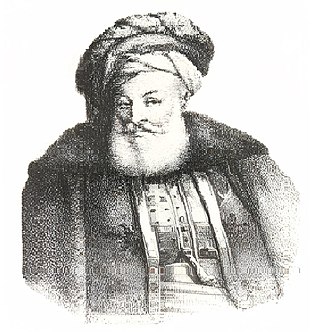
Ahmed Bey ben Mohamed Sherif, also known as Ahmed Bey or Hadj Ahmed Bey was the last bey of Constantine in the Regency of Algiers, ruling from 1826 to 1848. He was the successor of Mohamed Menamenni Bey ben Khan. As head of state, he led the local population in a fierce resistance to the French occupation forces. With the position vacant, in 1833 he adopted the title of leader of Algeria, and dey in exile، although this was not recognized by any other country. In 1837 Constantine was taken by the French after an intense siege. He retreated into the Aurès Mountains from where he continued to wage a low-intensity conflict with tribes still loyal to him, until he capitulated in 1848.
Salah Rais was the 7th King of Algiers, an Ottoman privateer and admiral. He is alternatively referred to as Sala Reis, Salih Rais, Salek Rais and Cale Arraez in several European sources, particularly in Spain, France and Italy.
Kouloughlis, also spelled Koulouglis, Cologhlis and Qulaughlis, but the translation of the word "kul" as slave is misleading since in the Ottoman context, it referred to one's special status as being in the special service of the sultan. It was a term used during the period of Ottoman influence in North Africa that usually designated the mixed offspring of Ottoman officials and janissaries, and local North African women.

Al-Husayn I ibn Ali, also known as Hussein I was the founder of the Husainid Dynasty, which ruled Tunisia until the abolition of the monarchy in 1957.

The Turkish communities in the former Ottoman Empire refers to ethnic Turks, who are the descendants of Ottoman-Turkish settlers from Anatolia and Eastern Thrace, living outside of the modern borders of the Republic of Turkey and in the independent states which were formerly part of the Ottoman Empire. Thus, they are not considered part of Turkey's modern diaspora, rather, due to living for centuries in their respective regions, they are now considered "natives" or "locals" as they have been living in these countries prior to the independence and establishment of the modern-nation states.

The French conquest of Algeria took place between 1830 and 1903. In 1827, an argument between Hussein Dey, the ruler of the Regency of Algiers, and the French consul escalated into a blockade, following which the July Monarchy of France invaded and quickly seized Algiers in 1830, and seized other coastal communities. Amid internal political strife in France, decisions were repeatedly taken to retain control of the territory, and additional military forces were brought in over the following years to quell resistance in the interior of the country.
The Turks in Libya, also commonly referred to as Kouloughlis(Arabic: كراغلة) are Libyans who claim partial descent from Ottoman Janissaries in Libya. Quantifiying their presence/population in Libya in the modern day is near impossible, due to them assimilating near entirely in the Libyan population over time. They mainly make up a small fraction of the populations of the cities, Misrata and Tripoli.
The Turks in Tunisia, also known as Turco-Tunisians and Tunisian Turks, are ethnic Turks who constitute one of the minority groups in Tunisia.

Ottoman Tunisia, also known as the Regency of Tunis, refers to the Ottoman presence in Ifriqiya from the 16th to 19th centuries, when Tunis was officially integrated into the Ottoman Empire as the Eyalet of Tunis. The Ottoman presence in the Maghreb began with the takeover of Algiers in 1516 by the Ottoman Turkish corsair and beylerbey Aruj, eventually expanding across the entire region except for Morocco. The first Ottoman conquest of Tunis occurred in 1534 under the command of Khayr al-Din Barbarossa, the younger brother of Aruj, who was the Kapudan Pasha of the Ottoman Fleet during the reign of Suleiman the Magnificent. However, it was not until the final Ottoman reconquest of Tunis from Spain in 1574 that the Turks permanently acquired the former territories of Hafsid Tunisia, retaining it until the French occupation of Tunisia in 1881.
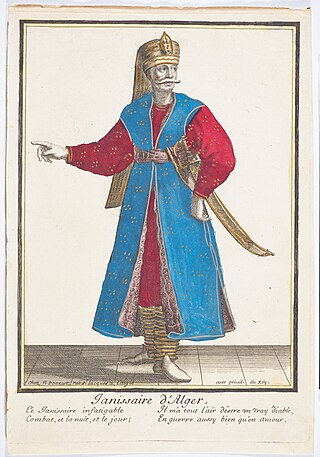
The Odjak of Algiers((efn|also spelled Ujaq was a unit of the Algerian army. It was a highly autonomous part of the Janissary Corps, acting completely independently from the rest of the corps, similar to the relationship between Algiers and the Sublime Porte. Led by an Agha, they also took part in the country's internal administration and politics, ruling the country for several years. They acted as a defense unit, a Praetorian Guard, and an instrument of repression until 1817.

The Beylik of Constantine, Beylik of the Sunrise or Beylik of the East as was its official designation, was one of the three Beyliks of the Regency of Algiers . The region liberated itself from the Hafsid Emirate of Béjaïa in the early 16th century, and constituted itself around Constantine in the mid to late 16th century. The Beylik collapsed in the 1837 siege of Constantine during the French conquest of Algeria. The Constantine department was formed upon the bases of the Beylik in 1848.

The Beylik of the West was one of three Beyliks (governorates) of the Regency of Algiers, with the other two being the Beylik of Titteri and the Beylik of Constantine. It was established in 1563, and it was ended during the French conquest.
Mohamed ben Hassan, also known as Muhammad III was during the reign of Baba Ali Chaouch khaznaji of Algiers before becoming Dey of Algiers from 1718 to 1724 as successor to Baba Ali I.
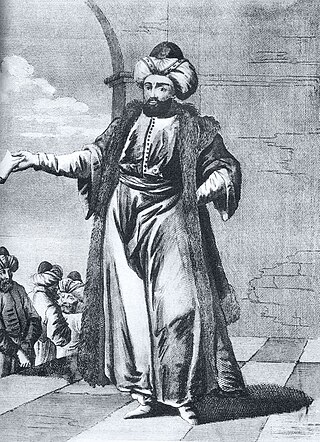
The Tunisian–Algerian War of 1807 was a conflict between the Beylik of Tunis and the Deylik of Algiers. The war led to the emancipation of Tunisia from any sort of Algerian influence, and the ending of the tribute paid by Tunisia to Algeria since 1756.
